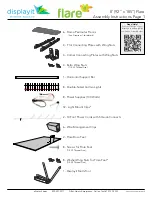
English-30
This LCD monitor can be controlled by connecting a personal computer with a RS-232C terminal.
NOTE:
When you use this function, EXTERNAL CONTROL should be “RS-232C” (See page 24).
Functions that can be controlled by a personal computer are:
• Power ON or OFF.
• Switching between input signals.
• Sound Mute ON or OFF.
Connection
LCD M computer
RS-232C Cable
Computer (Out)
RS-232C Cable
RS-232C (OUT)
MultiSync
RS-232C (IN)
RS-232C (OUT)
RS-232C (IN)
MultiSync
MultiSync
NOTE:
If your computer is equipped only with a 25-pin serial port connector, a 25-pin serial port adapter is required.
Contact your dealer for details.
Check the “ID=ALL REPLY” setting in “EXTERNAL CONTROL”.
* In order to function, the RS-232C OUT terminal can only be connected to another monitor of the same model.
Do not connect to other types of equipment.
To control monitor or multiple monitors that are daisy-chained together, please use the control command. Instructions for the
control command can be found on the CD included with the display. The file is called “External_control.pdf”.
Multiple monitors that are daisy-chained have a limit to the conectable monitor.
1) Interface
PROTOCOL
RS-232C
BAUD RATE
9600 [bps]
DATA LENGTH
8 [bits]
PARITY BIT
NONE
STOP BIT
1 [bit]
FLOW CONTROL
NONE
This LCD monitor uses RXD, TXD and GND lines for RS-232C control.
The reverse type cable (null modem cable) (not include) should be used for RS-232C control.
Controlling the LCD monitor via RS-232C Remote Control













































